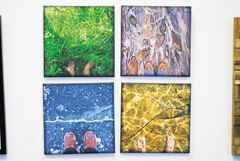Christian Quaresma
Contributor
Environmentalism has grown from looking at the world outside human spaces into something that encompasses life and the psychological spaces shared between people within the city.
York University’s Eco Art and Media Festival March 8 to 12 made this evolution prominent. Organized by the environmental studies department, it displayed a wide range of contributions from students across disciplines in an impressive variety of visual and performing arts.

The theme of this year’s festival was “Migration: Shaping and Reshaping,” a broad concept taken more literally in some submissions than others. The festival’s visual art inclusions ranged from a painting of a giant mallard to the open participation mural, which stood in the Centre for Fine Arts right next to the giant rocking horse. The 30-foot wide, ten-foot high mural, if you didn’t get chance to see it, featured beautifully drawn layers of artwork painted and stencilled on by passing students over the course of a few hours. The end result was a pastiche of our urban and mental environment containing pictures of buildings, birds and skulls, as well as the quote I’ve used to title this piece.
Though it was the “Eco” Art festival, the event was not overloaded with pieces that cried out against the ravaging of Earth. The focus seemed to be on human environments, and included the talk “Harvest Pilgrims” by photographer Vincenzo Pietropalo, who discussed the temporary migration of farm workers in Canada; and “Tales of Wander” by student Naja Dyrendom Graugaarrd, a spoken word performance of three ancient Inuit stories. For the more traditional environmentalists, there was an installation of a dollar sign constructed of recycled material in the foyer of the HNES building. The piece stood before the ZigZag Gallery, where the pieces from the festival can be viewed until the end of the month.
Thursday’s Human Library event expressed the ingenuity of the festival, providing attendees with “human books” to borrow for conversations based on each book’s expertise. Books from various backgrounds, including staff and students, were made accessible to share their stories of origin, discuss their chosen fields and offer insights on society from an environmental perspective.
The festival is in its 17th year and is still a relatively small event, organized by about fifty people and attended by a few hundred. The art was good, as were the performances, and was not grounded heavily in typical environmentalist ideology. Instead, the focus was on interaction between people and spaces.
As one student stated on opening night, “migration includes people, ideas, arts, disease and love, yes, love.”
Subscribe
Login
0 Comments
Oldest

